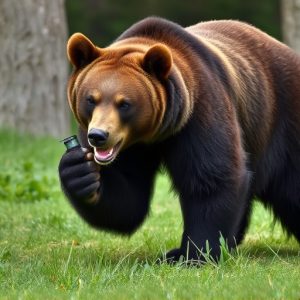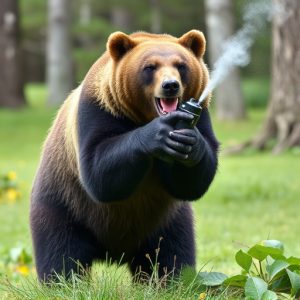Maximizing Bear Spray Power: Active Ingredients, Effective Distance, and Safety Tips
Bear spray, using capsaicin from chili peppers, effectively deters bears up to 20-30 feet (6-9 meter…….
Bear spray, using capsaicin from chili peppers, effectively deters bears up to 20-30 feet (6-9 meters) away by targeting their respiratory and olfactory systems. Ideal effectiveness distance varies based on factors like sprayer size, nozzle type, capsaicin concentration, weather, angle of aim, and terrain. Testing and certification by recognized organizations ensure quality protection. Safe use involves checking expiration dates, understanding the optimal range, adhering to technique instructions, and recognizing its role as a deterrent for escape time during encounters.
“Unveiling the Power of Bear Spray: Maximum Strength Capsaicin and Optimal Use. Bears, an inherent part of many outdoor adventures, can pose significant risks. This article delves into the science and effectiveness of bear spray, specifically focusing on its active ingredient, capsicin. We explore how this compound repels bears and discuss crucial factors influencing the best distance for optimal spray effectiveness.
From understanding key components to safety tips, we provide a comprehensive guide to ensure you’re prepared when facing these majestic yet potent creatures.”
- Understanding Bear Spray: Active Ingredients and Their Power
- The Science Behind Capsaicin and Its Effectiveness Against Bears
- Factors Affecting the Optimal Distance for Bear Spray Use
- Testing and Certification: Ensuring You Have the Best Bear Spray
- Safety Tips and Best Practices for Using Bear Spray Effectively
Understanding Bear Spray: Active Ingredients and Their Power
Bear spray, also known as bear repellent, is a powerful tool designed to deter aggressive bears and provide crucial time for escape in potentially dangerous encounters. Understanding its active ingredients is key to appreciating its effectiveness. The primary active ingredient in most bear sprays is capsaicin, the compound responsible for the heat and irritation felt from chili peppers. This chemical disrupts a bear’s sensory perception by targeting the olfactory (smell) and nerve endings in their respiratory system.
The maximum strength variant of bear spray boasts an enhanced concentration of capsaicin, making it more effective at longer ranges. The optimal distance for bear spray to be effective varies depending on factors like wind, terrain, and the size of the bear, but generally, users should aim to deploy the spray from a safe distance of 20-30 feet (6-9 meters). This allows the capsaicin to reach the bear’s eyes, nose, and mouth, creating an unpleasant experience that encourages the animal to retreat.
The Science Behind Capsaicin and Its Effectiveness Against Bears
The active ingredient in bear spray is capsaicin, a natural compound derived from chili peppers. This chemical irritates the sensory neurons in the animal’s eyes and nose, causing them to react instinctively by backing away rapidly. The science behind capsaicin’s effectiveness lies in its ability to interfere with the transmission of pain signals, leading to this reaction. When used correctly, bear spray can provide valuable time for humans to escape potentially dangerous encounters.
The best distance for bear spray effectiveness is typically around 25-30 feet (7.6-9 meters), though this can vary based on factors like wind and the size of the bear. At this range, capsaicin particles can attach to the bear’s fur and mucous membranes, initiating their escape response. It’s important to note that while bear spray is a valuable tool for deterring bears, it should be used as a last resort when physical attacks are imminent.
Factors Affecting the Optimal Distance for Bear Spray Use
When considering the best distance for bear spray effectiveness, several factors come into play. The optimal range varies based on the sprayer’s size and brand, with typical effective distances ranging from 20 to 35 feet (6 to 10 meters). This varies significantly due to the type of nozzle and the concentration of capsaicin, the active ingredient in bear spray.
Other key factors influencing the optimal distance include weather conditions—wind, temperature, and humidity can all affect how far the spray travels—and the angle at which the sprayer is aimed. In dense vegetation, the spray may not travel as far due to foliage interference, while open terrain allows for greater range. Understanding these variables is crucial in maximizing the effectiveness of bear spray during encounters in wild environments.
Testing and Certification: Ensuring You Have the Best Bear Spray
Testing and Certification are paramount when choosing bear spray, as they ensure your protection is of the highest quality. Reputable manufacturers subject their products to rigorous testing to determine effectiveness against bears at various distances—the best distance for bear spray effectiveness varies depending on factors like spray pattern, wind conditions, and spray concentration. Look for sprays certified by recognized organizations like the National Rifle Association (NRA) or similar bodies, which guarantee a minimum capsaicin level and consistent performance up to specified ranges.
These certifications offer peace of mind, assuring users that their bear spray has undergone extensive evaluations for both safety and efficacy. Understanding the testing protocols and certified standards helps ensure you’re carrying the best bear spray for your needs, providing confidence when navigating bear country or wilderness areas known for bear populations.
Safety Tips and Best Practices for Using Bear Spray Effectively
Using bear spray effectively requires adhering to safety tips and best practices. First, always check the expiration date and ensure your can is in good condition before heading into potential bear country. The best distance for bear spray effectiveness is typically around 20-30 feet (6-9 meters), but this can vary depending on factors like wind and the bear’s behavior. It’s crucial to follow the instructions provided by the manufacturer, including proper technique: aim low, just above the bear’s nose, and spray in a sweeping motion.
Avoid direct eye contact with the bear, as it may perceive this as a challenge. If the bear doesn’t retreat immediately, do not run—it might trigger their chase instinct. Instead, stand your ground or back away slowly while keeping an eye on the bear. Keep in mind that bear spray is designed to disable and deter bears, providing you time to escape if needed, but it doesn’t guarantee a full-proof protection against aggressive encounters.
Bear spray, particularly those with maximum strength capsaicin, has proven to be an effective deterrent against bear attacks. The key lies in understanding the active ingredients and their interaction with bears, as well as optimizing the best distance for bear spray effectiveness. Proper certification, safety tips, and best practices are essential to ensure its potency remains high when needed. By following these guidelines, users can enhance their chances of staying safe in bear country while enjoying the outdoors responsibly.


